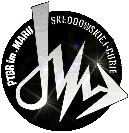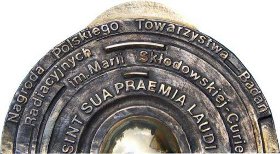Polish Radiation Research Society
 The Maria Skłodowska-Curie Polish Radiation Research Society (PRRS or PTBR in Polish) unites scientists involved or interested in studies and applications of ionizing and nonionizing radiation. The main goal of the Society is to support, promote, and popularize the development of radiation research. The Society provides opportunities for an exchange of ideas and results of studies among its members and fosters links between the scientific community and the general public. The PRRS also plays a unique educational role by organizing open seminars and ‘schools’ devoted to various aspects of ionizing and nonionizing radiation.
The Maria Skłodowska-Curie Polish Radiation Research Society (PRRS or PTBR in Polish) unites scientists involved or interested in studies and applications of ionizing and nonionizing radiation. The main goal of the Society is to support, promote, and popularize the development of radiation research. The Society provides opportunities for an exchange of ideas and results of studies among its members and fosters links between the scientific community and the general public. The PRRS also plays a unique educational role by organizing open seminars and ‘schools’ devoted to various aspects of ionizing and nonionizing radiation.
Address for correspondence:
Polish Radiation Research Society
National Institute of Public Health - National Institute of Hygiene
24 Chocimska St., 00-791 Warszawa
Phone: + 48 22 849 77 74; Fax: + 48 22 849 29 64
e-mail: [email protected]
History of the Society
The PRRS was founded in 1967 by a group of radiation chemists, physicists, engineers, and biologists. Altogether, thirty-one founder members participated in the first meeting of the Society held on June 29, 1967. At that meeting the official name of the Society was formulated, main rules of the statute were worked out, and the Organizing Committee was elected. Within eighteen months the statute of the PRRS was legally registered and the Society began its cooperation with the International Association for Radiation Research (IARR) and the European Society for Radiation Biology (ESRB). During the first National Scientific Meeting which was organized on January 8, 1969, and attracted 314 members Prof. Jerzy Kroh was elected as first President of the PRRS, Dr. Janusz Beer - as Secretary, and Assoc. Prof. Roman Broszkiewicz - as Treasurer. Over the following years the PRRS membership fluctuated and on the turn of the twentieth and twenty-first century a little more than 280 members were registered. Currently, the Society unites researchers and practitioners from such fields as chemistry (34%), biology (24%), physics (8%), agronomy (6%), and other areas (11%). The national scientific meetings are organized every three years and are tied to the General Assembly of the Members. Since 1970 the Society has regularly organized its five-day “Autumn Schools” targeted at both members and non-members of the PRRS as well as at the general public. The Schools’ programmes have covered topics ranging from basic research on the effects and applications of radiation to protection against and attenuation and treatment of its adverse health effects (the School Directors are the recognized specialists from the respective areas). Until 2009 the School seminars were attended by over 1,600 participants, some 400 lectures were given, and over 160 reports were presented by the attendees. The PRRS issues its own bulletin and publishes the Autumn School lectures in the form of a separate monograph.
In addition, many important scientific conferences and meetings have been organized including:
- Kraków 1981
- The 16th Annual Meeting of the European Society for Radiation Biology (ESRB),
- Radiation Sterilization and Preservation
- Modification of Radiosensivity in Biological Systems
- Kraków 1995
- The International Seminar on “100 years of discovery of X-rays by W.C.Roentgen”
- Kraków 1997
- "Radioactivity: Risk and Hope", the conference on the 130'th Anniversary of the Birth of Maria Skłodowska-Curie and 100-th Anniversary of the Discovery of Polonium and Radium
- Warszawa 2000
- The 30th Annual Meeting of the European Society for Radiation Biology (ESRB)
Authorities
The General Assembly of the Members is a supreme authority of the PRRS. It convenes every three years (during the National Scientific Meetings) and elects the General Council (GC), the Supervisory Board, and the Arbitration Court of the Society. The GC of the PRRS serves as the main authority in the periods between the National Meetings.
The General Council (GC)
Currently (for the term of 2007-2010) the GC of the PRRS consists of:
President:
Prof. Marek Janiak
[email protected]
Vice Presidents:
Assoc. Prof. Ewa Szajdzińska-Piętek
[email protected]
Assoc. Prof. Marek Zmyślony
[email protected]
Secretary:
Dr. Krzysztof Pachocki
[email protected]
Treasurer:
Prof. Marcin Kruszewski
[email protected]
Council Members:
Prof. Antonina Cebulska-Wasilewska
[email protected]
Dr. Wiesława Barszczewska
[email protected]
Dr. Beata Biesaga
[email protected]
Assoc. Prof. Anna Lankoff
[email protected]
Assoc. Prof. Jerzy Lech Gębicki
[email protected]
Prof. Andrzej Wójcik
[email protected]
Supervisory Board:
Prof. Anna Gasińska
[email protected]
Assoc. Prof. Maria Hilczer
[email protected]
Assoc. Prof. Roman Kubacki
[email protected]
Arbitration Court
Prof. Irena Szumiel
[email protected]
Prof. Antoni Gajewski
Prof. Zbigniew Zagórski
[email protected]
The Awards Committee:
Assoc. Prof. Ewa Szajdzińska-Piętek (chair)
Assist. Prof. Anna Lankoff
Dr. Krzysztof Pachocki
Assist. Prof. Marek Zmyślony
Awards
The PRRS honours distinguished radiation scientists with the Maria Skłodowska-Curie Medal and the PRRS Scientific Awards. The PRRS Awards Committee verifies applications for the Medal and the Awards, calls reviewers, and presents its nominations to the GC of the PRRS.
The Maria Skłodowska-Curie Medal

The medal was originally designed by a contemporary Polish artist Józef Markiewicz. In 1997 it was redesigned by a young talented artist Hanna Jelonek. The front of the bronze-cast medal boasts a profile of Maria Skłodowska-Curie surrounded by the words “sint sua praemia laudi”, the reverse shows a graphical representation of the alpha, beta, and gamma radiations emitted by a slice of metal that imitates a radiation source, the name of the recipient, and the medal number. The medal is awarded to Polish scholars recognized for their achievements in radiation research as well as to foreign scientists for their contribution to the progress of radiation research in Poland. The medallists are appointed by the General Council of the PRRS by way of a secret ballot.
Scientific Awards

Every three years the General Council of the PRRS awards the selected best papers in the field of radiation biology, physics, chemistry, and radiation protection. In 1995 the financial awards were replaced with statuettes and diplomas. Until now, 38 awards in radiation chemistry and 29 awards in radiobiology have been awarded to 238 radiation research workers including over 30 foreign scientists.
Recipients of the Maria Skłodowska-Curie Medal:
- 1983
- Prof. F.S. Dainton (Great Britain)
- Prof. Maria Kopeć
- Prof. Bogusława Jeżowska-Trzebiatowska
- 1986
- Prof. Jerzy Kroh
- Prof. Tadeusz Rudnicki
- Prof. I.F. Fowler (Great Britain)
- Prof. A.K. Pikajew (Russia)
- 1989
- prof. A. Charlesby (Great Britain)
- prof. Antoni Dancewicz
- prof. Józef Mayer
- prof. K. Trott (Great Britain)
- 1992
- Prof. R.H. Schuler (USA)
- Prof. J. Beer (Poland, USA)
- Prof. Zenon Bałtrukiewicz
- Prof. Władysława Pękala
- 1995
- Prof. Adolphe Chapiro (France)
- Prof. Larry Kevan (USA)
- Prof. Jan Skołyszewski
- Prof. Zbigniew Zagórski
- 1998
- Prof. Jacquline Belloni (France)
- Prof. Irena Szumiel
- Prof. S. Potten (Great Britain)
- Prof. G.A. Salmon (Great Britain)
- Prof. D.A. Amstrong (Canada)
- 2001
- Prof. Clemens von Sonntag (Germany)
- Prof. Christian Streffer (Germany)
- Prof. Andrzej Płonka
- Prof. Zbigniew Szot
- 2004
- Prof. Klaus-Dieter Asmus (Germany)
- Prof. Thomas Bally (Switzerland)
- Prof. Jerzy Kaleciński
- Prof. Stanisław Szmigielski
- 2007
- Prof. Shulamith Schlick (USA)
- Dr Kenneth H. Chadwick (UK)
- Dr Hendrik P. Leenhouts (Netherlands)
- Prof. Jerzy Gębicki
- Prof. Julian Liniecki
Scientific meetings
The National Scientific Meetings of the Society are held every three years. Thus far, twelve meetings have been organized at the following locations: Warszawa (1969), Poznań (1971), Łódź (1973), Kraków (1976), Warszawa (1979), Wrocław (1983), Łódź (1986), Poznań (1989), Kraków (1992), Warszawa (1995), Siedlce (1998), Kraków (2001), Łódź (2004), and Kielce (2007). On average, 150-160 participants attended per meeting. Although the majority of the presentations have come from the fields of radiobiology, radiation chemistry, and photochemistry, other subjects such as protection against ionizing and nonionizing radiation have also been represented.
List of the Autumn Schools of the Polish Radiation Research Society
| No | Year | Topic |
|---|---|---|
| I | 1970 | Radiation sources and the work methodology in radiation research. |
| II | 1972 | Photochemical and photobiological methods in radiation laboratories. |
| III | 1974 | Current problems of radiobiology with special regard to the late effects of radiation. |
| IV | 1974 | Radiation techniques in agriculture and food technology. |
| V | 1977 | Sterilization, preservation and radiation consolidation. |
| VI | 1978 | Dosimetry in a radiobiological experiment for medicine and agriculture needs. |
| VII | 1981 | Radiation and isotope techniques in natural environment protection – needs, possibilities and practice. |
| VIII | 1984 | Nuclear energy – its influence on people and their natural environment. |
| IX | 1985 | Radiation techniques in production and modification of polymer materials. |
| X | 1987 | Biological effect, medical application and protection from magnetic and electromagnetic fields |
| XI | 1988 | Damages of nuclear reactors and their effects. |
| XII | 1990 | Radiation problems of nuclear energy in Poland. |
| XIII | 1991 | Radiation techniques in medicine, in environmental protection, and in food and related products. |
| XIV | 1993 | The influence of electromagnetic waves on the living organisms. |
| XV | 1994 | Irradiated food. |
| XVI | 1996 | Chernobyl – 10 years later. Health outcomes, food and environmental pollution. |
| XVII | 1997 | Radon – its occurrence and consequences. |
| XVIII | 2000 | Biological effect, health risk and protection against the influence of electromagnetic fields. |
| XIX | 2002 | Ionizing radiation in medicine. Exposure and patient protection, quality control, legal regulations. |
| XX | 2004 | Electromagnetic fields in the environment and at the workplace - sources and effects on humans |
| XXI | 2006 | Chernobyl - 20 years after. Contamination of food and the environment and health effects |
| XXII | 2008 | Electromagnetic fields in the environment - aspects of health, environment, measurement and administration |
Regional Sections
The PRRS operates through its four regional sections grouping local members in Warszawa, Łódź, Kraków, and Siedlce. The primary objective of these sections, which elect their own authorities, is to promote excellence in the field of radiation research in their regions. Presidents of the local sections are regulary invited for discussions at the meetings of the General Council of the Society.

